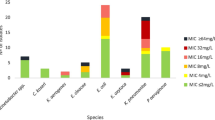Abstract
In our tertiary care center, the reported susceptibility of E. coli blood isolates to amoxicillin/clavulanic acid exceeded 90% in 2005 and showed a progressive decrease to 50% by 2017. In this study, we investigate whether there is a real increase in resistant E. coli strains or if this apparent decline in reported susceptibility might be attributed to the substitution of CLSI by EUCAST guidelines in 2014. We randomly selected 237 E. coli blood isolates (stored at − 80 °C) from 1985 to 2018 and reassessed their MIC values, applying both the CLSI (fixed ratio of clavulanic acid) and EUCAST guidelines (fixed concentration of clavulanic acid). In parallel, the susceptibility of these isolates was retested by disk diffusion, according to the EUCAST guidelines. Whole genome sequencing was successfully performed on 233 of the 237 isolates. In only 130 of the 237 isolates (55.0%), testing according to the EUCAST and CLSI criteria delivered identical MIC values for amoxicillin/clavulanic acid. In 64 of the 237 isolates (27.0%), the MIC values diverged one dilution; in 38 (16.0%), two dilutions; and in five (2.1%), three dilutions. From these 107 discrepant results, testing according to EUCAST methodology revealed more resistant profiles in 93 E. coli strains (94.1%). Also, phenotypical susceptibility testing according to EUCAST guidelines tends to correlate better with the presence of beta-lactamase genes compared to CLSI testing procedure. This study highlights the low agreement between EUCAST and CLSI methodologies when performing MIC testing of amoxicillin/clavulanic acid. More strains are categorized as resistant when EUCAST guidelines are applied. The low agreement between EUCAST and CLSI was confirmed by WGS, since most of EUCAST resistant/CLSI sensitive isolates harbored beta-lactamase genes.




Similar content being viewed by others
References
Kaper JB, Nataro JP, Mobley HLT (2004) Pathogenic Escherichia coli. Nat Rev Microbiol 2(2):123–140. https://doi.org/10.1038/nrmicro818
Mora-Rillo M et al (2015) Impact of virulence genes on sepsis severity and survival in Escherichia coli bacteremia. Virulence 6(1):93–100. https://doi.org/10.4161/21505594.2014.991234
Micenková L et al (2017) Human Escherichia coli isolates from hemocultures: Septicemia linked to urogenital tract infections is caused by isolates harboring more virulence genes than bacteraemia linked to other conditions. Int J Med Microbiol 307(3):182–189. https://doi.org/10.1016/j.ijmm.2017.02.003
Berg RD (2000) Bacterial translocation from the gastrointestinal tract. Adv Exp Med Biol 473(4):11–30. https://doi.org/10.1007/978-1-4615-4143-1_2
Nataro JP, Kaper JB (1998) Diarrheagenic Escherichia coli. Clin Microbiol Rev 11(1):142–201. https://doi.org/10.1128/cmr.11.1.142
Clinical and laboratory standards institute (2018, January). M07 11th edition - Methods for dilution antimicrobial susceptibility tests for bacteria that grow aerobically
Clinical and laboratory standards institute (2020) M100 30th edition – performance standards for antimicrobial susceptibility testing
EUCAST (2020) Testing Breakpoint tables for interpretation of MICs and zone diameters. pp. 0–77. https://www.Eucast.Org/Ast_of_Bacteria/. [Online]. Available: https://www.eucast.org/fileadmin/src/media/PDFs/EUCAST_files/Breakpoint_tables/v_10.0_Breakpoint_Tables.pdf
Cusack TP et al (2019) Impact of CLSI and EUCAST breakpoint discrepancies on reporting of antimicrobial susceptibility and AMR surveillance. Clin Microbiol Infect 25(7):910–911. https://doi.org/10.1016/j.cmi.2019.03.007
EUCAST, EUCAST frequently asked questions (2020). Retrieved from https://www.eucast.org/fileadmin/src/media/PDFs/EUCAST_files/General_documents/FAQ/FAQ_EUCAST_20180216.pdf
Committee TE, Testing AS, Changes N, Pseudomonas E (2015) European Committee on Antimicrobial Susceptibility Testing Breakpoint tables for interpretation of MICs and zone diameters European Committee on Antimicrobial Susceptibility Testing Breakpoint tables for interpretation of MICs and zone diameters. pp. 0–77. http://www.eucast.org/fileadmin/src/media/PDFs/EUCAST_files/Breakpoint_tables/v_5.0_Breakpoint_Table_01.pdf. [Online]. Available: http://www.eucast.org/fileadmin/src/media/PDFs/EUCAST_files/Breakpoint_tables/v_5.0_Breakpoint_Table_01.pdf
Delgado-Valverde M et al (2017) MIC of amoxicillin/clavulanate according to CLSI and EUCAST: discrepancies and clinical impact in patients with bloodstream infections due to Enterobacteriaceae. J Antimicrob Chemother 72(5):1478–1487. https://doi.org/10.1093/jac/dkw562
Area of Technical Uncertainty (ATU) in antimicrobial susceptibility testing (2020) Retrieved from European Committee on Antimicrobial Susceptibility Testing: https://www.eucast.org/fileadmin/src/media/PDFs/EUCAST_files/Breakpoint_tables/Area_of_Technical_Uncertainty_-_guidance_v2_2020.pdf
Antibiotic resistance (2020) Retrieved from World Health Organisation: https://www.who.int/news-room/fact-sheets/detail/antibiotic-resistance
Claudio U, Köser MJ (2014) Whole-genome sequencing to control antimicrobial resistance. Trends Genet 401–407
Jacoby GA (2009) AmpC β-Lactamases. Clin Microbiol Rev 161–182
Acknowledgements
The authors acknowledge Marina Van Cauwenbergh, Annick Soetaert, and Elly Roebben for providing technical assistance for antibiotic susceptibility testing.
Author information
Authors and Affiliations
Contributions
VR, DT, and PD contributed to the writing of the article. BN and CF performed the practical work. PD and DT helped with the design of the study. BK helped with the statistical analysis.
Corresponding author
Ethics declarations
Ethics approval
Not applicable.
Consent to participate and for publication
Not applicable.
Competing interests
The authors declare no competing interests.
Additional information
Publisher's Note
Springer Nature remains neutral with regard to jurisdictional claims in published maps and institutional affiliations.
Rights and permissions
About this article
Cite this article
Vanstokstraeten, R., Belasri, N., Demuyser, T. et al. A comparison of E. coli susceptibility for amoxicillin/clavulanic acid according to EUCAST and CLSI guidelines. Eur J Clin Microbiol Infect Dis 40, 2371–2377 (2021). https://doi.org/10.1007/s10096-021-04297-0
Received:
Accepted:
Published:
Issue Date:
DOI: https://doi.org/10.1007/s10096-021-04297-0




